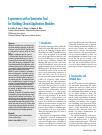Subscribe to RSS
DOI: 10.1055/s-0038-1634207
Experiences with a Generator Tool for Building Clinical Application Modules
Publication History
Publication Date:
07 February 2018 (online)

Summary
Objectives: To elaborate main system characteristics and relevant deployment experiences for the health information system (HIS) Orbis®/ OpenMed, which is in widespread use in Germany, Austria, and Switzerland.
Methods: In a deployment phase of 3 years in a 1.200 bed university hospital, where the system underwent significant improvements, the system’s functionality and its software design have been analyzed in detail. We focus on an integrated CASE tool for generating embedded clinical applications and for incremental system evolution. We present a participatory and iterative software engineering process developed for efficient utilization of such a tool.
Results: The system’s functionality is comparable to other commercial products’ functionality; its components are embedded in a vendor-specific application framework, and standard interfaces are being used for connecting subsystems. The integrated generator tool is a remarkable feature; it became a key factor of our project. Tool generated applications are workflow enabled and embedded into the overall data base schema. Rapid prototyping and iterative refinement are supported, so application modules can be adapted to the users’ work practice.
Conclusions: We consider tools supporting an iterative and participatory software engineering process highly relevant for health information system architects. The potential of a system to continuously evolve and to be effectively adapted to changing needs may be more important than sophisticated but hard-coded HIS functionality. More work will focus on HIS software design and on software engineering. Methods and tools are needed for quick and robust adaptation of systems to health care processes and changing requirements.
-
References
- 1 Nadkarni PM, Marenco L, Chen R, Skoufos E, Shepherd G. Miller: Organization of heterogeneous scientific data using the EAV/CR representation. J Am Med Inform Assoc 1999; Nov-Dec; 6 (Suppl. 06) 478-93.
- 2 Lilienthal C, Züllighoven H. Techniques and tools for continuous user participation. In: Blomberg J, Kensing F, Dykstra-Erickson E. eds. PDC ‘96 Proc. of the Participatory Design Conference,. 1996: 153-9.
- 3 Kruchten P. The Rational Unified Process – An Introduction. 2nd edition. Boston, MA: Addison Wesley; 2000
- 4 Beck K. Extreme Programming – Das Manifest. München: Addison Wesley; 2000. (in German).
- 5 Lechleitner G, Pfeiffer KP, Wilhelmy I, Ball M. Cerner Millennium™: the Innsbruck experience. Methods Inf Med 2003; 42: 8-15.
- 6 Gell G, Schmücker P, Pedevilla M, Leitner H, Naumann J, Fuchs H, Pitz H, Köle W. SAP and Partners: IS-H and IS-H*MED. Methods Inf Med 2003; 42: 16-24.
- 7 Safran C. Special issue on legacy systems. Int J Med Inf 1999; 54: 155-262.
- 8 Kuhn KA, Giuse DA. From hospital information systems to health information systems – problems, challenges, perspectives. Methods Inf Med 2001; 40: 275-87.
- 9 Haux R, Seggewies C, Baldauf-Sobez W, Kullmann P, Reichert H, Luedecke L, Seibold H. Soarian - Workflow management applied for health care. Methods Inf Med 2003; 42: 25-36.
- 10 Orfali R, Harkey D, Edwards J. Client/server survival guide. New York: J Wiley; 1999
- 11 Xu Y, D’Alessio L, Jaulent MC, Sauquet D, Spahni S, Degoulet P. Integrating medical applications in an open architecture through generic and reusable components. In: Patel V, Rogers R, Haux R. eds. Medinfo 2001. Proceedings of the 10th World Congress on Medical Informatics. Amsterdam, IOS Press; 2001: 63-7.
- 12 Geissbühler A, Lovis C, Lamb A, Spahni S. Experience with an XML/HTTP-based federative approach to develop a hospital-wide clinical information system. In: Patel V, Rogers R, Haux R. eds. Medinfo 2001. Proceedings of the 10th World Congress on Medical Informatics. Amsterdam, IOS Press; 2001: 735-9.
- 13 Bosch J. Software product lines: organizational alternatives. In: Proceedings of the 23rd International Conference on Software Engineering, ICSE 2001. IEEE Computer Society; 2001: 91-100.
- 14 Lorenzi NM, Riley RT. Managing change: an overview. J Am Med Inform Assoc 2000; 7: 116-24.
- 15 Sauer C. Deciding the future for IS failures: Not the choice you might think. In: Currie W, Galliers R. eds. Rethinking Management Information Systems. Oxford University Press; 1999: 279-309.
- 16 Coiera E. When conversation is better than computation. J Am Med Inform Assoc 2000; 7 (Suppl. 03) 277-86.
- 17 Anderson JG. Clearing the way for physicians’ use of clinical information systems. Commun ACM 1997; 40: 83-90.
- 18 Berg M. Patient care information systems and health care work: a sociotechnical approach. Int J Med Inf 1999; 55: 87-101.
- 19 Leape LL. A systems analysis approach to medical error. J Eval Clin Pract 1997; 3: 213-22.
- 20 Berg M, Toussaint P. The mantra of modeling and the forgotten powers of paper: a sociotechnical view on the development of process-oriented ICT in health care. Int J Med Inf. 2003 (in press).
